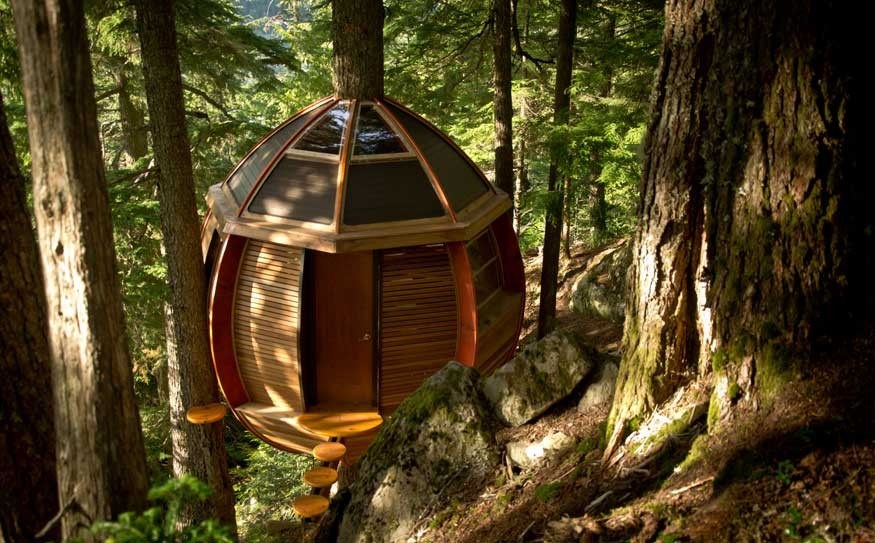An elegant, egg-shaped treehouse built somewhere in the woods of Whistler Mountain is attracting international attention after being featured in Dwell Magazine.
It's far from being the first squat built in Whistler's forests — the current mayor lived in a squat when she arrived here in the '70s — but it's definitely the most unique. As of this week the HemLoft's blog website at www.thehemloft.com had over 4,000 Facebook "Likes" and has been posted to Twitter and Reddit.
Now the builders, Joel Allen and his wife Heidi, are wondering what to do with it. Since it's on Crown land it's not exactly legal, and Allen is concerned that the project — which represents several years of planning and two months of hard work — could be taken down.
"It took a lot of work to build it, and I'd rather not take it down just yet," he wrote on his blog. "So I've been thinking of ways to expose the HemLoft while somehow making it legal. To the best of my knowledge, squatting on Whistler Mountain beneath some of Western Canada's most luxurious mega-homes would not be looked favourably upon."
One of those ideas is trying to buy the land the tree is on, about nine square feet of Crown land in an undisclosed location. Another is to make it a protected camping area, open to the public on a limited basis.
Allen said he's amazed by the attention that his project has received. He originally planned to keep it a secret, but more and more people were learning about it until he made the conscious decision to go public.
"I never built it with the intention of going public with it in any way, but when it was finished I started to tell a few people about it," he said. "It was really rewarding because I put a ton of work into it, and people were telling me to submit it to a magazine. To my surprise, Dwell accepted it... and it kind of shifted from being a secret."
Now Allen doesn't know what to make of all the attention. "As I went through it I was so focused on the next step, the next challenge... so it was hard to step back and see it from the outside," he said.
The two storey HemLoft wraps around the trunk of a tree — a hemlock, obviously — and includes a deck with a sliding glass door, fully enclosed living space with a loft, and a roof lined with triangular windows to let in the light. A step is cut into a stump and people can get into the house by stepping on round platforms that reach the door. It's also on the side of a steep hill with a view of the surrounding forest and sunshine from the southwest.
Allen is a former programmer who once had plans to retire by age 26. Once he tried to create a global fundraiser to accomplish this, but in the end found himself taking a carpentry job to pay the bills while living out of his car.
The HemLoft hasn't resulted in any contracts to build anything yet, but Allen said there is some interest. In that sense his tree house has been a great calling card.
"I think one of my goals in life is just to build cool things, and I would love for work to come out of it," he said. "Right now I'm doing a cool design-build project with an architect in Salmon Arm, and it's really fun and I'm learning a lot about architecture. I'm really interested in design, and I'd like to continue building cool things — and would welcome any opportunity that comes my way."
The egg concept dates back to 2008, with Allen's architect friends helping to create the basic model. That year he built the frame, but he wouldn't finish the project for several years.
He's spent at least $6,500 on tools and materials and estimated that it would take another $10,000 to finish it. To offset some of the costs he used salvaged construction materials.
While Allen wouldn't recommend that everybody design and build tree houses on Crown land, there are lessons to be learned from the project.
"Through the whole process I had a lot of people that were readily pointing out that it was highly impractical and expensive and could almost in some ways be considered a waste of time. And there were a lot telling me, 'c'mon, it's just a tree house, why do you care about this detail or that detail?'" said Allen. But for Allen the challenge was what made the experience fun.
"Through the whole process I was very uncompromising and I'm glad I wasn't," he said. "I was very dedicated in my head about the vision and blocked out any thought that it wouldn't happen, and kept working on it.
"I never dreamed that this would be the final outcome, getting into a publication and getting attention, I really didn't have an end game — I just wanted to build something beautiful. I wasn't trying for anything except to satisfy my own desire in some ways."
A diary of the building process and photos are available at www.hemloft.com.




